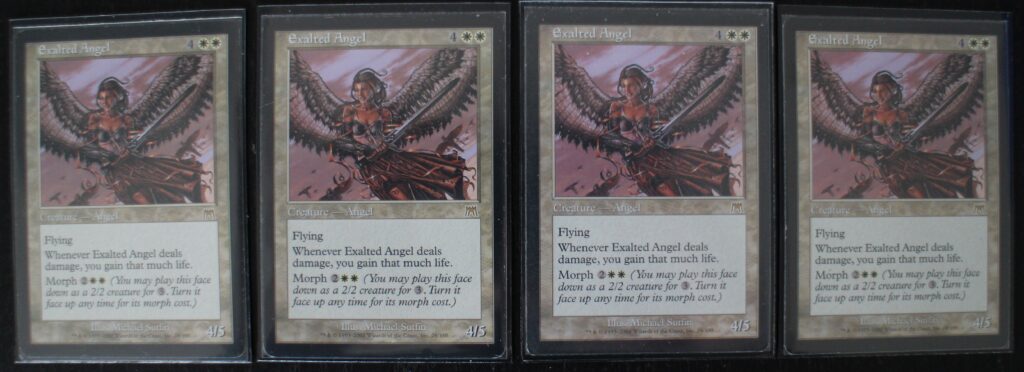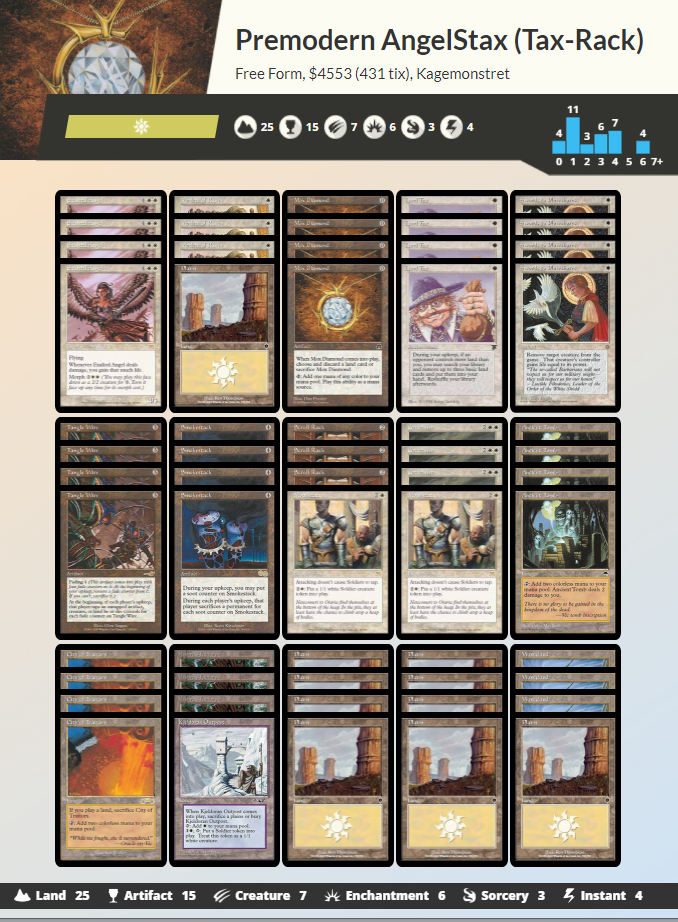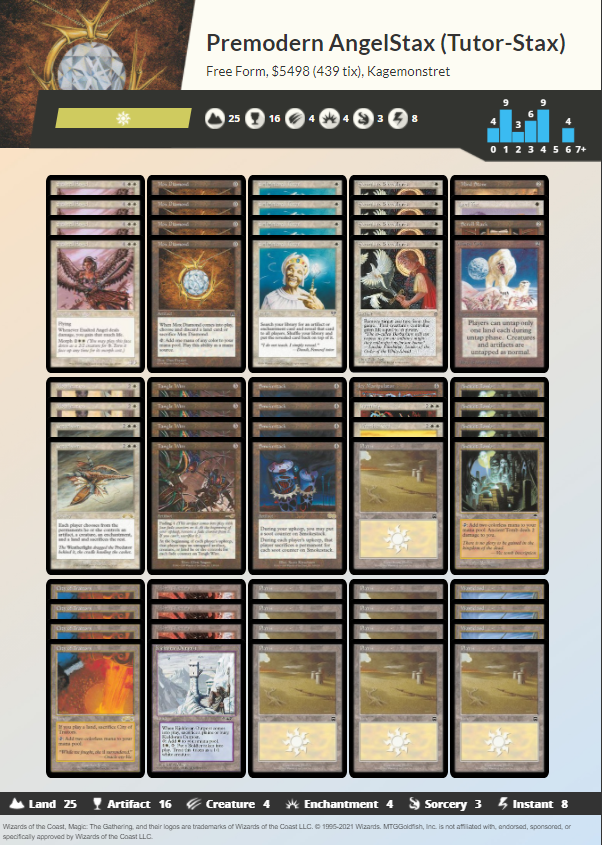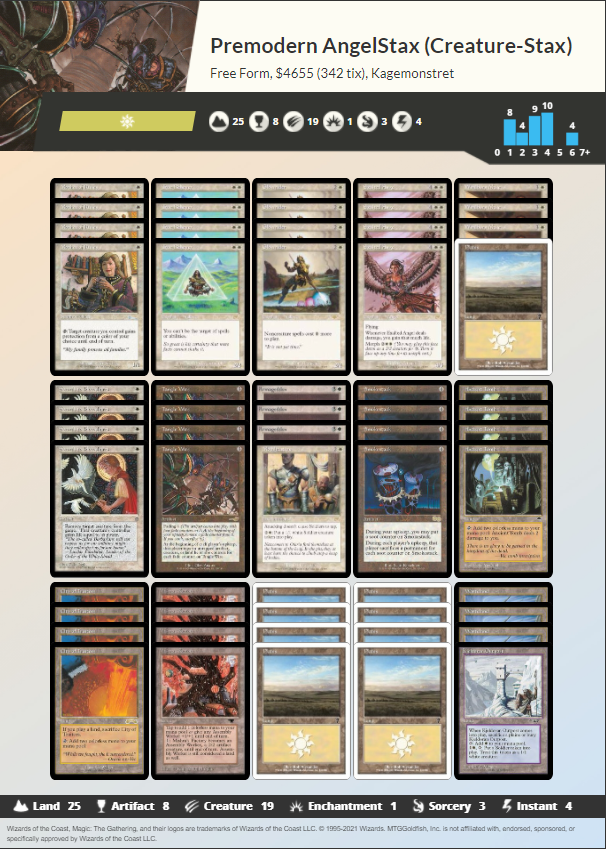Back in the early days of Legacy, a quite fantastic deck emerged at one point – the AngelStax. Not a much played or very winning deck. But in my view, it has always been a great deck. I like the gameplan, I like the cards.
I love the Angel!

You can find the lists and some discussion on the archetype here.
A monowhite deck built around stax-components and Exalted Angel. Uh! Do I love those Exalted Angels! Did I mention that?
Fast mana in the form of Ancient Tomb, City of Traitors and Mox Diamonds speeds the game plan up. Armageddon together with Crucible of Worlds make opponents cry and Ghostly Prison keep critters at bay. This was a rather classic take on the Stax archetype with all the flaws and strengths that come with this type of deck. But the Angel gave it an edge in some matchups, or, at least, a rather fast way of ending the game.
I haven’t seen anything like Angel Stax in Premodern. The closest thing has been White Weenie and monobrown Stax.
I want to build Angel Stax in Premodern!
What did AngelStax look like?
The most important Stax component in the Legacy deck was Chalice of the Void. Chalice had two major functions: 1. It protected our Angel from the omnipresent Swords to Plowshares (or, when unmorphed, Lightning Bolt). 2. It simply won games against a major part of the field playing blue cantrips or red goblins.
The Chalice was followed by other pieces of the prison, namely premodern all-stars like Tangle Wire and Smokestack. Sometimes even Sphere of Resistance. But also cards like Trinisphere, Ghostly Prison and Suppression Field.
This deck leans heavily on Chalice of the Void and Trinisphere to control the stack and Ghostly Prison and Moat to control the board. Apart from the misers Mishra’s Factory, it only has three Exalted Angels as kill. It is a bit light, and we probably can’t afford to go so light. But, of course, we must remember, that the Factory could come back via Crucible of Worlds – another great card, which we unfortunately don’t have access to.
In short: I think we need a bit more, safe kill conditions than this sample decklist presents. More on that later.
How did AngelStax work?
The deck is a rather standard Stax-deck, which tries to overwhelm the opponent with permanents containing some kind of tax-effects, to hinder him playing his game. Smokestack works wonders, when you also have a Crucible of Worlds in play. Suppression Field made all fetchlands really bad and so on.
The deck was capable of completely locking the opponent out of the game from turn one, by casting either Trinisphere or Chalice and then following up with Crucible and Wasteland. Not many opponents could win through that.
The reason why this deck didn’t see much play, nor win a lot, was, of course, because of the prevalence of Force of Will and Daze in Legacy at the time. If your opponent led with an Island, you were often in for a difficult game. It often also had troubles against fast aggro-strategies, if it wasn’t able to find one or more of the creature control cards. Which points to another of the decks problems: The lack of card draw and/or filtering.
What building blocks do we have – which do we need?
In Premodern, we have to think a bit differently. Chalice and Trinisphere are the cards who controlled the stack. It is basically what made Stax decks go over the top, because these cards enabled the Stax player to control both the stack and the board. Sadly, they are not legal in Premodern, so we have to venture other routes, to make sure our Angel hits the opponent in the face at least 5 times. Crucible of Worlds and Ghostly Prison are no-gos too.
But there are still a lot of cards available, to build a strong deck. And seeing as Force of Will is banned and Daze is not played very much, we may be able to build a deck that actually has a shot. It probably won’t be Tier1, but I think it will be fun, if you enjoy playing stax or prison strategies.
The fact that we can’t play Chalice actually opens up some space for including some of the very greatest cards in the format, that wasn’t played in Legacy because of the non-bo between Chalice and cc1 cards. This means we can play Swords to Plowshares, Enlightened Tutor, Land Tax and even consider Mother of Runes and Argivian Find.
But this is not all. There is a plethora of relevant cards to be picked from, when building a monowhite Stax deck in Premodern. From the top of my head in no specific order:
Argivian find, Tangle Wire, Winter Orb, Mox Diamond, Smokestack, Aura of silence, Sphere of resistance, Black Vise, Ankh of Mishra, Icy Manipulator/Ring of Gix, Cataclysm, Cursed Totem, Decree of justice, Seal of Cleansing, Swords to plowshares, True Believer, Mishra’s Helix, Mobilization, Drifting meadow, Earnest fellowship (pro swords), Eternal Dragon, Tsabo’s web, Glowrider, Humility, Kjeldoran Outpost, Mishra’s factory, Exalted Angel, Mother of Runes, Armageddon, Windborn Muse, City of Traitors, Ancient Tomb, Peacekeeper and probably a lot of other great options, who can strengthen different strategies.
The most obvious includes are the ones also played back then in Legacy: Tangle Wire, Smokestack and Exalted Angel. Along with a manabase of Ancient Tomb, City of Traitors, Mox Diamonds and a mix of Wasteland and Mishra’s Factory. I think these cards should form the basis of the deck (at least if you want to call it AngelStax…) But from there, you have several options. I have made three decklist, I want to present to you today. They share the core, but from there, they go down three different lanes.
Tax-Stax
The first one is a very controlling, slow deck that tries to build card advantage with the Tax-Scroll engine. Aside from the engine the decks consists of the stax elements.

As you will also notice in the other two decklists, I opt for Mobilization as a secondary kill condition. It is not very fast, but it has the added feature of being able to making Smokestack with a single counter one-sided, which can be huge if assembled fast enough. The same is true for Kjeldoran outpost. I only play one copy as the 25th land, because it requires you to sacrifice a land when it enters the battlefield. We cannot afford to risk throwing away resources and dying to a well-timed opposing Wasteland.
I have opted for a manabase with three Mishra’s Factories and no Wastelands. It may be a mistake, but we often want to hit WW relatively early in the game.
Finally, Cataclysm! Cataclysm can be very game-winning if set up correctly (or if you are lucky). It is another good reason to play a kill condition in the form of an enchantment (Mobilization). Cataclysm is one of the absolute best cards in the deck.
The three Mother of Runes can easily be swapped out for something else. But I wanted something to protect my Angels. True Believers could be another option here, but it strains your mana a bit. Windborn Muse is also a very relevant option in many matchups. And it flies.
Tutor-Stax
This decks looks a lot like the former, but I have opted to play Enlightened Tutor along with some silver bullet targets. You can obviously change the tutor-targets to your liking, but I would recommend to keep two Mobilizations main. It is nice to sometimes naturally draw it.

I have changed one of the Cataclysms to a Wrath of God. It may be a mistake, but I wanted to try the Wrath in one of the decks. Wrath of God is often great, as we don’t have a lot of creatures on the board.
It is difficult to say whether it is Tax-Rack or Tutor that is the right call. The problem with Tutor is, that it is card disadvantage. But of course, being able to find the relevant Stax piece, when you need it – or a silver bullet to get rid of a problem is a very big advantage in the deck!
Creature-Stax
Finally I have tried a completely different approach. Actually, this deck is probably much closer to White Weenie or another old Legacy deck called Angel Stompy.

In this deck we don’t want any Cataclysm, because they kill most of our creatures.
We opt for Armageddon! A couple of creatures and a fast Armageddon will often be enough to seal the deal.
Wrapping it up
As I mentioned at the beginning of this rather long article, these decks probably won’t show up in a lot of finals in the coming time. They are not Tier1. But I think they can be a lot of fun to play. They require skill as well as training to play correctly, and one of the great parts about the archetype, is that it can be built in many different ways.
I hope you have enjoyed my endeavor to make an AngelStax deck in Premodern.
If you normally read this blog because you play Old School, consider making a Premodern deck or two. It is a great format, and – maybe apart form an AngelStax deck – it is VERY CHEAP.
Thank you for reading. I hope I’ll meet you to a friendly (-ish, playing Stax and all) battle one day!